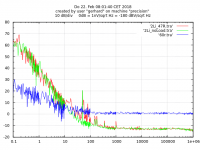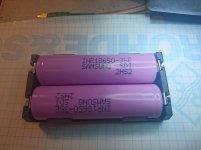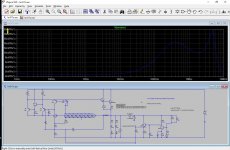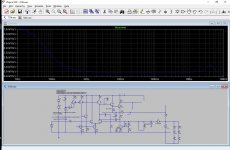but use the pass transistor and accept it being not short circuit proof.
If you are planning the circuit enough carefully, it's feasible.
Pass transistor B-E voltage usually produced by the series resistor voltage drop. This resistor usually serial with the LDO, so LDO's maximum (LT 3042/3045 has Ilimit input) current limits the B-E voltage, so limits pass transistor's maximum current.
BTW chinese "datasheet clones" don't use any planning.
there are many people who speak about lipo battery , they have read stuf here or there , they think , this or that ....
but very few have test them in lab condition ,or/and in audio setup , so what else to say
as Democritus says :"Nothing exists except atoms and empty space , everything else is opinion” .....
.
Let's change that.
2 Panasonic 18650 Lithium batteries in series, abt. 7V, in the state as bought last week,
they might not be completely full.
Noise behavior of the batteries is excellent. The blue line is the measured noise of
a 60 Ohm resistor. That is 1nV of thermal noise at room temperature.
The 60 Ohm resistor is on the amplifier side of the coupling capacitor.
There is one trace without load and one trace with a 47 Ohms ceramic load resistor.
It got a little bit to hot for my fingers. :-(
The input capacitor is only 100uF foil. The batteries are on the far end of the
coupling capacitor, as seen from the amplifier. That leads to the steep rise
of the noise at low frequencies since the noise of the bias circuit (10K)
cannot be shorted through the capacitor & low impedance DUT.
This is an artefact of the amplifier. It could be healed by using a bigger cap.
I tried organic polymer electrolytics, but they had to much leakage current,
they messed up the bias system. There is a lot of gain involved.
I have some wet slug tantals, but they do not fit mechanically.
There are no facts, only interpretations. (F. Nietzsche)
Attachments
Last edited:
There are no facts, only interpretations. (F. Nietzsche)
So what do we learn from the interpretations ? That one specific kind of battery has very good properties and that any regulator needed behind it has worse noise specs ? Please tell what you think of this matter. Should one have benefits by using these specific batteries followed by LT3042/3045 regulators for a DAC or XO ?
BTW too bad about the leakage current of polymer electrolytic caps but it is a feature of the used technology. The other relevant specs are quite impressive.
* I wish to give some attention to the fact that these batteries can cause quite hefty explosions when charged wrong or when shorted. Any beginning DIYer should not bother to use these. In any case, wear safety goggles when working with high capacity batteries. make sure you understand what you are dealing with. Please also note that batteries should be used in a well ventilated area. Cabling should be done with utmost care for safety, the correct wire gauge for the maximum possible current and the correct fuses MUST be used. Care should be taken into verifying that the Li-po, LiPoFe4 batteries and their kind are equipped with an internal safety and charging circuit. Chargers should be adapted for the use of exactly the batteries they are designed for, have temperature compensation and should have the exact right specifications. Don't take unnecessary risks by buying unbranded or possible fake stuff from cheap suppliers as you can have unpredictable results. Always measure the wiring before you switch and only switch it on for the first time at a safe distance and NEVER in a home.
Since I use to work with high capacity batteries and have seen some spectacular effects I think i am not exaggerating as we are on a DIY hobby forum where many not fully grasp all aspects. Recent batteries can develop quite some current, more than suitable for normal users anyway. I have nothing against batteries (except that I avoid them when I can) but regret their impact on the environment.
Last edited:
The interpretations?
All fat batteries seem to be quite good, the NiCd, NiMH in my test report and also
the Li Ion measured this morning. Led acid has to wait until it is warm enough
outside so I can work on my motorcycle.
The effort to measure that is quite high. My personal interest is measurement amplifiers
and there it is a definite plus when they are an order of magnitude better than the
devices under test. Batteries make life easier here, alone for the elimination of ground loops.
I need multi level metallic shielding, and even then a ground loop in the innermost box
is easily seen in the spectrum.
There is no need for this performance level in audio. The perceived need could
"at best" be justified by incompetent amplifier design. DIY and "Hi End" designers
seem to flock to circuits that have no power supply rejection, for simplicity, ignorance,
tunnel vision or fashion. For me that's wrong from the start, more a symptom than a feature.
The LT3042 is 40 dB better than the rest of the crowd like LM317. If that is
not sufficient, something else must be wrong.
< VoltageRegulators | Output noise of some voltage regulators.… | Flickr >
I also do not see the importance of ultra high PSSR in regulators. If you
ever should need 100+ dB, that would mean that on your board, less than 1 cm
away from your precious circuit, is an incredible pile of dirt that should be
removed in the first place. That dirt will find other ways to sneak in.
Having a LT3042 after a LiIon battery will probably worsen the noise.
But when you need 3.3V +-5%, then you need 3.3V +-5%.
I have made a LT6655 reference that approaches -12 dB below 1nV/rt Hz
by filtering. That probably impairs the precision of the reference. The plot is
in the above flicker album, as well as the 3042 with external power transistor
just like the one in the data sheet.
cheers, Gerhard
All fat batteries seem to be quite good, the NiCd, NiMH in my test report and also
the Li Ion measured this morning. Led acid has to wait until it is warm enough
outside so I can work on my motorcycle.
The effort to measure that is quite high. My personal interest is measurement amplifiers
and there it is a definite plus when they are an order of magnitude better than the
devices under test. Batteries make life easier here, alone for the elimination of ground loops.
I need multi level metallic shielding, and even then a ground loop in the innermost box
is easily seen in the spectrum.
There is no need for this performance level in audio. The perceived need could
"at best" be justified by incompetent amplifier design. DIY and "Hi End" designers
seem to flock to circuits that have no power supply rejection, for simplicity, ignorance,
tunnel vision or fashion. For me that's wrong from the start, more a symptom than a feature.
The LT3042 is 40 dB better than the rest of the crowd like LM317. If that is
not sufficient, something else must be wrong.
< VoltageRegulators | Output noise of some voltage regulators.… | Flickr >
I also do not see the importance of ultra high PSSR in regulators. If you
ever should need 100+ dB, that would mean that on your board, less than 1 cm
away from your precious circuit, is an incredible pile of dirt that should be
removed in the first place. That dirt will find other ways to sneak in.
Having a LT3042 after a LiIon battery will probably worsen the noise.
But when you need 3.3V +-5%, then you need 3.3V +-5%.
I have made a LT6655 reference that approaches -12 dB below 1nV/rt Hz
by filtering. That probably impairs the precision of the reference. The plot is
in the above flicker album, as well as the 3042 with external power transistor
just like the one in the data sheet.
cheers, Gerhard
Last edited:
My personal interest is measurement amplifiers
and there it is a definite plus when they are an order of magnitude better than the
devices under test. Batteries make life easier here, alone for the elimination of ground loops.
I need multi level metallic shielding, and even then a ground loop in the innermost box
is easily seen in the spectrum.There is no need for this performance level in audio.
The LT3042 is 40 dB better than the rest of the crowd like LM317. If that is
not sufficient, something else must be wrong.
Having a LT3042 after a LiIon battery will probably worsen the noise.
But when you need 3.3V +-5%, then you need 3.3V +-5%.
You use a lot of words to nearly say the same
BTW thank you for the graphs/plots, it took a lot of your valuable time and I only need to look at them for confirmation/verification. As a DIYer with only one life I only want optimal results and this data saves a lot of time.
So... we are stuck at LT3042 and forget to even think about LM317. Gerhard also provided info that the optimum load cap for the LT3042 is 4.7µF. Overdoing gets us a noise peak. Well, 4.7 µF does not seem a problem to me.
Anyone bidding higher than using LT3042/3045 with an output cap of 4.7 µf for feeding DAC chips and/or XO's ?
Last edited:
Gerhard what was load and voltage at lt3042 and 4u7 cap? What was 22uf? Ceramics tantal or electrolytic?
Btw thank you for your test pictures. I also went to similar results wit lt3045 and batteries. Therefore my power supply for rpi is nimh 5.7V than tps for 5v and lt3045 dual version(1A) for 3.3v and 1.8v.
Btw thank you for your test pictures. I also went to similar results wit lt3045 and batteries. Therefore my power supply for rpi is nimh 5.7V than tps for 5v and lt3045 dual version(1A) for 3.3v and 1.8v.
You use a lot of words to nearly say the sameHigh PSRR does not exactly hurt does it ?
BTW thank you for the graphs/plots, it took a lot of your valuable time and I only need to look at them for confirmation/verification. As a DIYer with only one life I only want optimal results and this data saves a lot of time.
So... we are stuck at LT3042 and forget to even think about LM317. Gerhard also provided info that the optimum load cap for the LT3042 is 4.7µF. Overdoing gets us a noise peak. Well, 4.7 µF does not seem a problem to me.
Anyone bidding higher than using LT3042/3045 with an output cap of 4.7 µf for feeding DAC chips and/or XO's ?
If you are absolutely pushing the noise envelope and don't want to use either a/ batteries or b/ discrete custom design, another option is paralleling LT3042/3045's. The data sheet explains. So theoretically 4 should give 6dB less noise.
Terry
Gerhard, thank you for your excellent measurement. My power supply for an OP amp is usually four LiPO(+8V and -8v) without a regulator. A voltage reference is LiPO with the LT3042. I sometimes need a negative supply for passive I/V stage to keep compliance voltage. Problem is no negative supply like LT3042. Direct usage of LiPO without a negative regulator is possible in this situation because compliance voltage doesn't need accuracy. It works well without degradation of SNR though I haven't measured LiPO noise performance so far. I'm sure now without a regulator is a better solution in this case.
But LiPO and other battery have an incredible high current capability which can cause a fire easily. Protected type(the additional circuit is cheap) is necessary. I usually disconnect them from a board when not in use for safety. You must keep it in mind battery is dangerous.
But LiPO and other battery have an incredible high current capability which can cause a fire easily. Protected type(the additional circuit is cheap) is necessary. I usually disconnect them from a board when not in use for safety. You must keep it in mind battery is dangerous.
Low noise application is where discrete transistors have advantages over ICs, regulators are not exceptions.(Gerhard, you must have professional knowledge about them.) So paralleling LT3042 or even one LT3042 are a bit extravagant I think. Pictures below is I am simulating, discrete + uA723 or LM317. They exhibit below 1nV/sqrtHz in audio frequency and DC tolerance and stability of ICs. Though this is not complete circuit, no discharging diode for caps yet.
BTW I agree to diyralf's opinion, I know circuit like this or LT3042 are objectively overquality to typical audio circuits but it is fan to be a audiophile.
BTW I agree to diyralf's opinion, I know circuit like this or LT3042 are objectively overquality to typical audio circuits but it is fan to be a audiophile.
Attachments
It Will cost more money and time to build a circuit that performs equally well. LM723 is very good but at the cost of higher component count and it is not LDO.
I don’t see an objection to choose the best available part for 5 Euro. At least one area of the design will cause no sorrows.
I don’t see an objection to choose the best available part for 5 Euro. At least one area of the design will cause no sorrows.
I noticed that the data sheet states that you may require more than 4.7uf depending on the application. So in practice, the 4.7uf would produce the best results for a given (low) load.
There may have been an esr mention as well but I don’t recall at the moment, will have to go look again.
Better and inexpensive, I like it...
There may have been an esr mention as well but I don’t recall at the moment, will have to go look again.
Better and inexpensive, I like it...
If you use a transformer with separate secondary windings, not center tapped, you can use a positive reg configured in the return path to the bridge rectifier. Look at the St1000A RF SigGen schematics, they use a uA723(LM723) in this config.Problem is no negative supply like LT3042.
It does not matter if your power supply has 2mV ripple and noise or 500uV. The performance data of the audio circuit does not change thereby. You can not hear what you can not measure.
Are you the same guy who posts on ComputerAudiophile as 'Ralf11' ??
- Home
- Source & Line
- Digital Line Level
- Low noise regulator for DAC & clock



